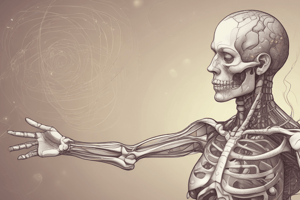Podcast
Questions and Answers
What causes the reddish color of the lips?
What causes the reddish color of the lips?
- Keratin and vascularity (correct)
- The presence of melanin in the skin
- Inflammation from chewing
- A thick layer of skin on the lips
What is the main function of the orbicularis oris muscle?
What is the main function of the orbicularis oris muscle?
- Protecting the inner oral tissues
- Supporting the structure of the face
- Regulating what comes in and goes out of the mouth (correct)
- Regulating the sensations of taste
Which part of the lips is described as the transition area between skin and mucous membrane?
Which part of the lips is described as the transition area between skin and mucous membrane?
- Vermillion (correct)
- Labial frenum
- Oral fissure
- Philtrum
What are the nasalabial folds?
What are the nasalabial folds?
What is the function of the labial frenum?
What is the function of the labial frenum?
Which structure is described as the horizontal opening between the lips leading into the oral vestibule?
Which structure is described as the horizontal opening between the lips leading into the oral vestibule?
Where is the parotid papilla located?
Where is the parotid papilla located?
What anatomical feature runs vertically down the center of the upper lip?
What anatomical feature runs vertically down the center of the upper lip?
What is the function of the vestibule in the oral cavity?
What is the function of the vestibule in the oral cavity?
Which structure is NOT part of the oral cavity proper?
Which structure is NOT part of the oral cavity proper?
What is the role of the lingual frenulum?
What is the role of the lingual frenulum?
Which type of epithelium is primarily found in the oral mucosa?
Which type of epithelium is primarily found in the oral mucosa?
Which statement about the masticatory mucosa is correct?
Which statement about the masticatory mucosa is correct?
Which part of the oral cavity is responsible for the sensory function related to taste?
Which part of the oral cavity is responsible for the sensory function related to taste?
What differentiates the labial vestibule from the buccal vestibule?
What differentiates the labial vestibule from the buccal vestibule?
Which of the following is NOT a feature of the oral mucosa?
Which of the following is NOT a feature of the oral mucosa?
Flashcards are hidden until you start studying
Study Notes
Oral Cavity
- Also known as the buccal cavity or mouth, surrounded by cheeks, tongue, and palate.
- Divided into two main parts: vestibule and oral cavity proper.
Vestibule
- Outer, narrower cavity with two subdivisions:
- Labial vestibule: Space between the inner lips and anterior teeth with gingivae.
- Buccal vestibule: Space between inner cheeks and posterior teeth with gingivae.
Oral Cavity Proper
- Inner, larger cavity framed by:
- Teeth: Includes anterior (facing lips) and posterior (facing cheeks) teeth.
- Palate: Comprises hard and soft palate.
- Tongue and floor of mouth: Features the dorsum (with papillae) and ventral surface attached to the floor via the lingual frenulum.
- Oropharynx: Section located at the back of the mouth.
Oral Mucosa
-
Lining: Comprised of non-keratinized mucous membrane allowing for flexibility and stretching. Covers:
- Soft palate
- Ventral tongue surface
- Inner surfaces of lips and cheeks
- Alveolar process
- Hard palate covering and gingiva
- Dorsal surface of the tongue has various lingual papillae with mechanical and sensory functions.
-
Masticatory: Features moderately thick epithelium, often orthokeratinized with parakeratinized areas in gingiva. Designed to withstand abrasion.
-
Specialized: Includes additional unique structures adapted for specific functions.
Lips
- Lips (labia) serve as the entrance to the mouth and cover the orbicularis oris muscle, crucial for oral control.
- Vermillion border: Area where skin transitions to mucous membrane, vascular and thinly keratinized, contributing to their red appearance.
- Oral fissure: The horizontal opening between the lips leading into the vestibule.
- Labial frenulum: Midline fold attaching the inner lip surface to gingiva.
- Philtrum: Vertical groove from nose to upper lip center.
Cheeks
- Defined by nasolabial fold and sulcus: Indentations extending from the nose to the mouth corners.
- Gingival margin/crest: Indicates the space between the nose wing and lip.
- Parotid papilla: Projection observed from inner cheeks, marking the opening of the parotid duct.
Studying That Suits You
Use AI to generate personalized quizzes and flashcards to suit your learning preferences.




